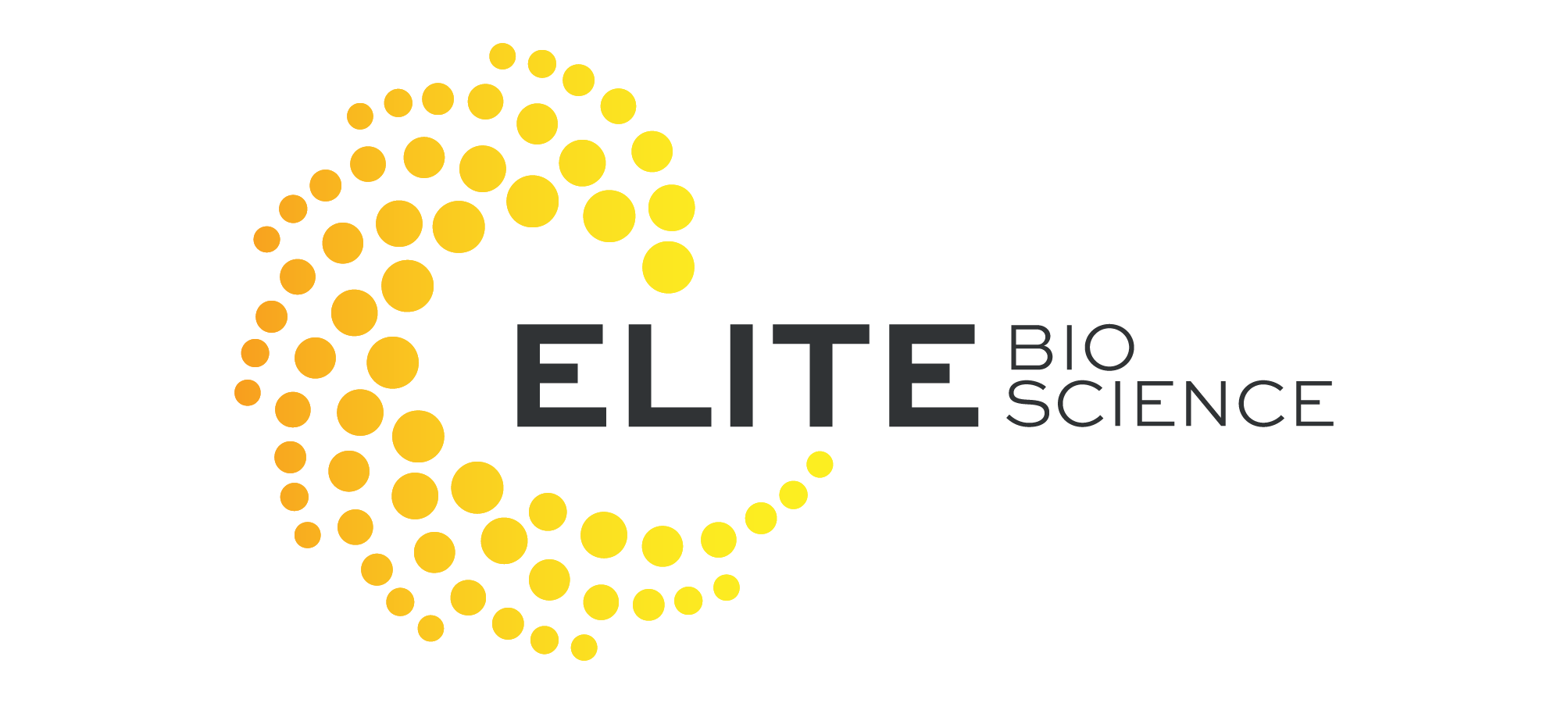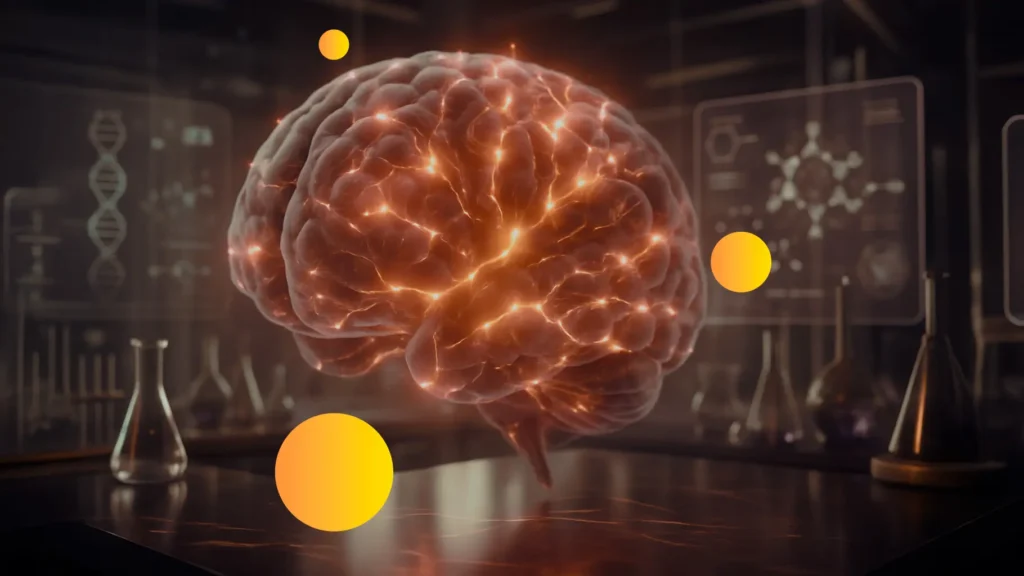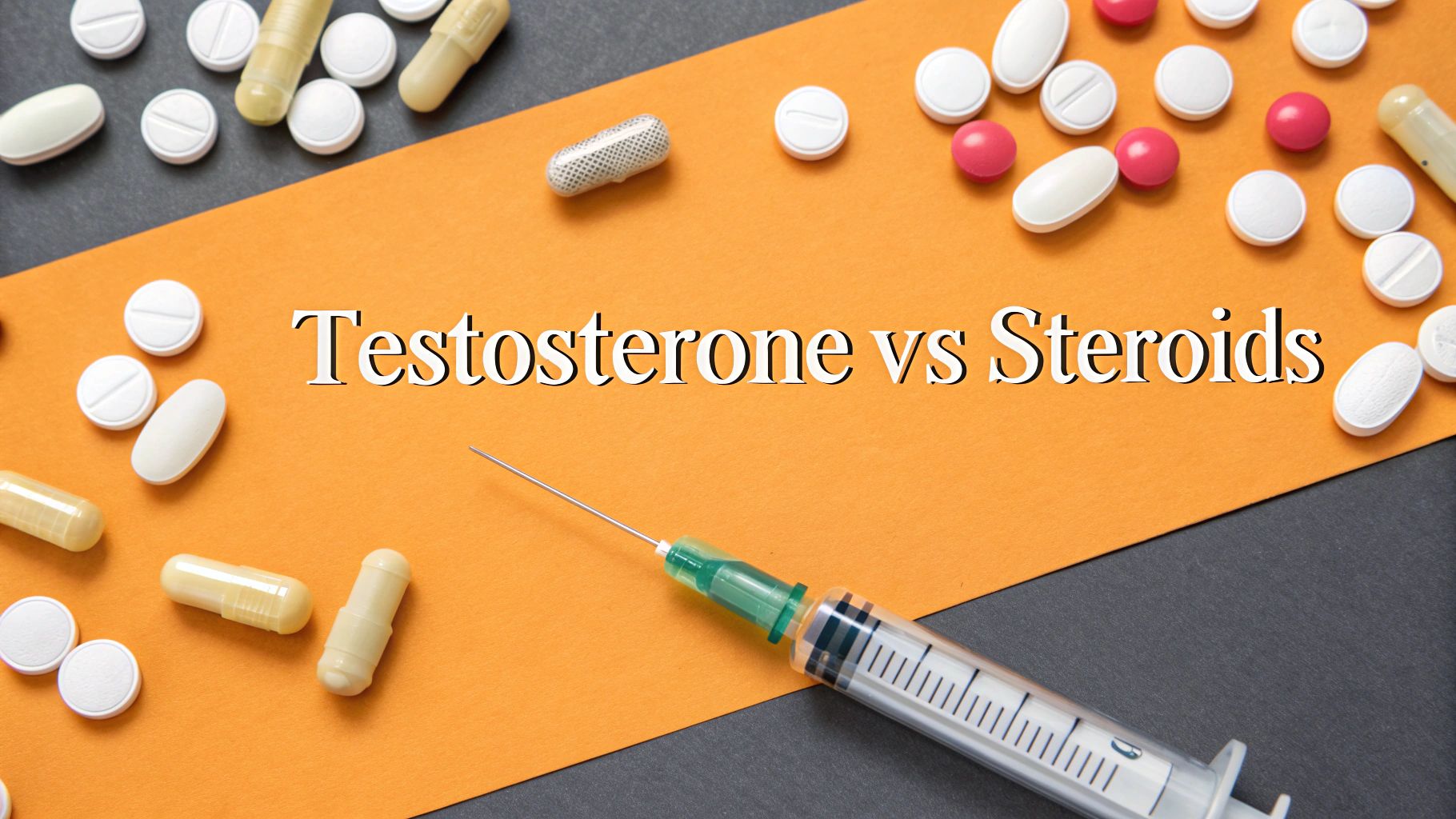Let's get right to it: peptides are short chains of amino acids that act as precision messengers inside your body. Think of them as highly specific keys, each designed to fit a particular lock in the brain to trigger a specific function. These molecules are getting a lot of attention for their potential to support everything from memory recall to mental clarity and overall neurological resilience.
What Are Peptides and How Do They Affect the Brain?
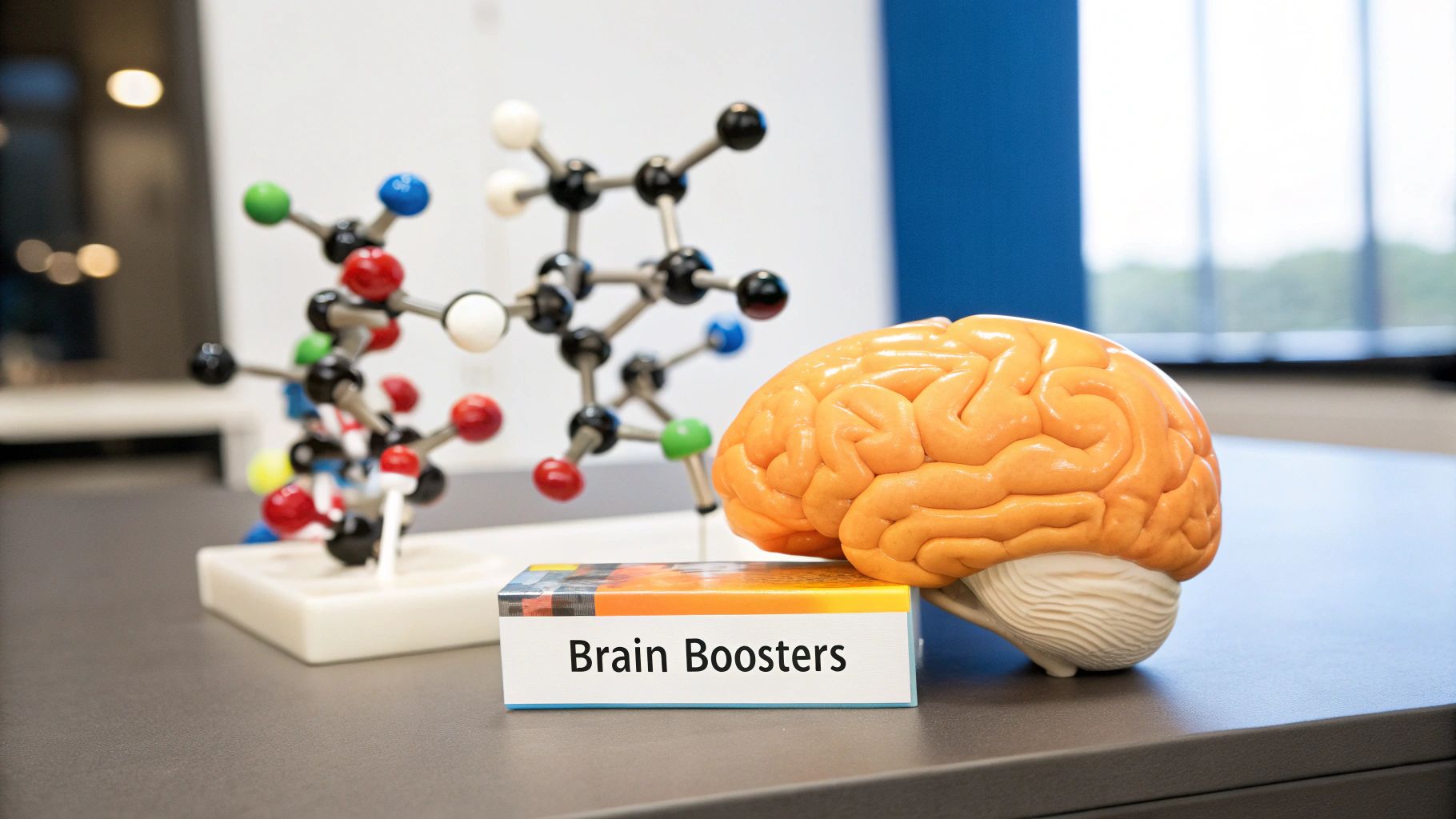
To really grasp what peptides do for brain health, you have to think about how our body communicates with itself. It's a massive, complex network of signals, and peptides are some of its most important couriers. They're essentially smaller, more focused versions of proteins, but their size gives them a huge advantage—the ability to deliver incredibly specific instructions directly to your cells.
Imagine your brain as a sprawling, intricate command center. Peptides function like targeted memos sent straight to the right department. Instead of a building-wide announcement that might disrupt everyone (like some broad-spectrum supplements can), a peptide delivers its message only to the team that needs it. This could be the memory storage department, the mood regulation unit, or the team responsible for new neuron construction.
The Role of Amino Acids
At their core, peptides are built from amino acids, which are the fundamental building blocks of life. When these amino acids link together in short chains—usually 50 or fewer—they form a peptide. The exact sequence and structure of these amino acids are what determine the peptide’s job, giving it a unique "biochemical password" to interact with certain receptors in the brain.
This targeted action is what makes peptides for brain health such a compelling field. Instead of just indirectly influencing brain function, they can potentially interact directly with the systems that govern:
- Neurogenesis: The actual creation of new brain cells, or neurons.
- Synaptic Plasticity: The strengthening or weakening of connections between neurons, which is the physical basis of learning and memory.
- Inflammation Control: Managing the brain's immune response to keep chronic inflammation in check, as this can damage neurons over time.
Researchers are increasingly focused on the brain's unique immune system, especially the role of cells called microglia. Peptides that can dial this response up or down are a huge area of interest, since out-of-control inflammation is now closely linked to cognitive decline.
A Roadmap to Key Brain Peptides
Navigating the world of brain-focused peptides can feel like a lot at first, since each one has a distinct purpose. To make things a bit clearer, here's a quick summary table outlining the main players we'll be exploring in this guide.
This table will give you a bird's-eye view of each peptide, its primary target in the brain, and the potential benefits it might offer. Think of it as your roadmap for the sections ahead.
Key Peptides for Brain Health at a Glance
| Peptide | Primary Cognitive Target | Potential Benefit |
|---|---|---|
| Semax | Neurotransmitter regulation & BDNF stimulation | Enhanced focus, attention, and memory formation |
| Selank | Anxiety reduction & mood stabilization | Reduced stress, improved mood, and cognitive calming |
| Dihexa | Neuron growth & synaptic connection (Hepatocyte Growth Factor) | Potential for profound cognitive repair and enhancement |
| Cerebrolysin | Neuroprotection & neurotrophic support | Support for recovery from brain injury and neurodegeneration |
| BPC-157 | Systemic healing & dopamine system modulation | Neuroprotective effects and mood regulation support |
We'll dive much deeper into each of these compounds, but this summary is a great starting point for understanding the diverse applications of peptides for brain health.
How Peptides Cross the Blood-Brain Barrier
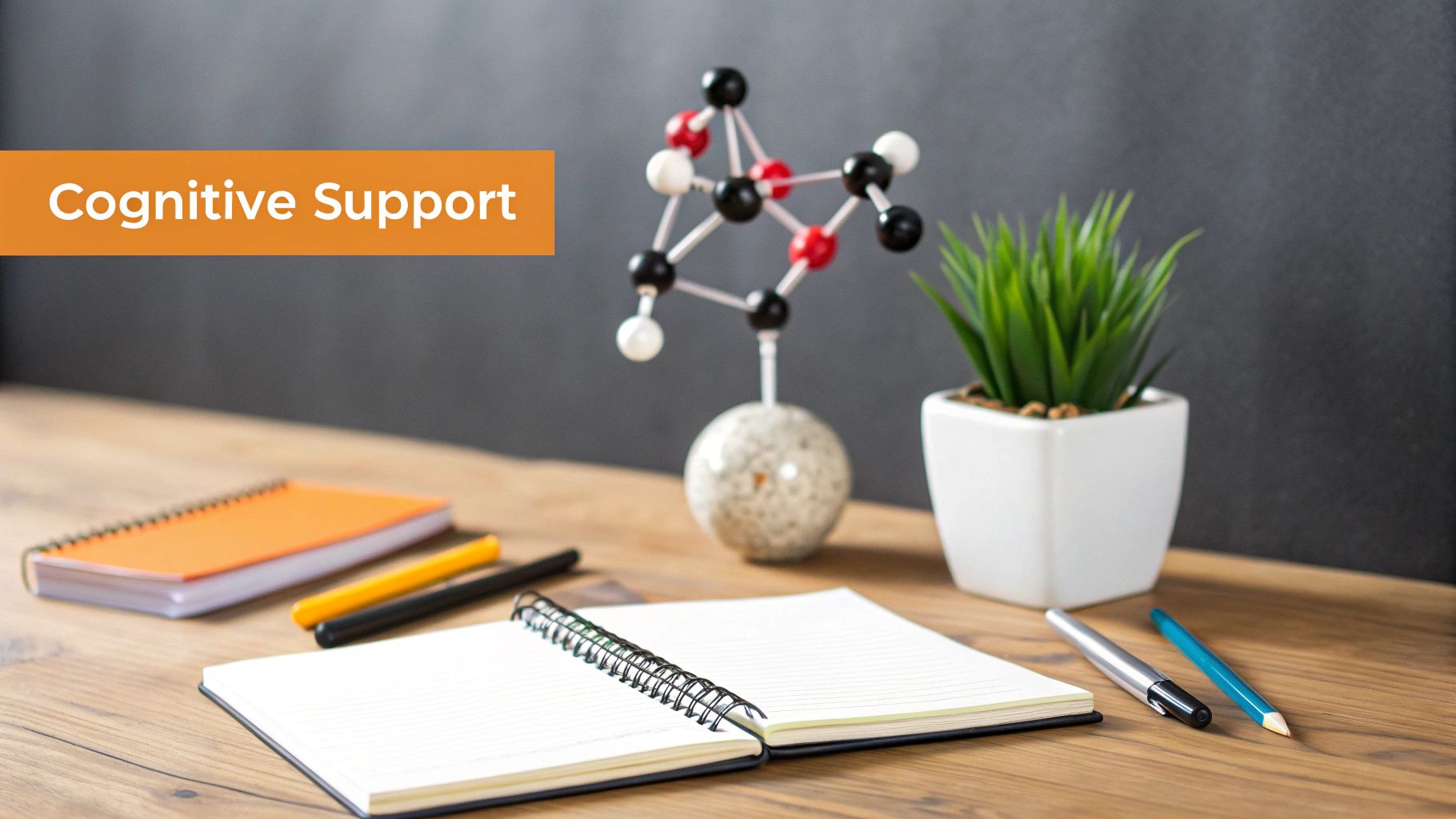
The brain is our body's most heavily guarded asset, protected by a highly selective fortress called the blood-brain barrier (BBB). Think of it as an elite security checkpoint that strictly controls what gets in and what stays out. This system is brilliant for keeping out toxins and pathogens, but it also creates a major challenge for getting therapeutic compounds where they need to go.
So, how do peptides designed for brain health get past this formidable defense? The answer lies in their unique structure, which can act like a special biochemical password or a VIP access key. Not all peptides can cross the BBB, but the ones that do often use specific transport mechanisms to gain entry. Some are small and fat-soluble enough to passively slip through, while others are actively shuttled across by specialized receptor systems.
Scientists are getting incredibly clever about this. For example, recent research has explored using segments of viruses that are naturally good at entering the brain—like the rabies virus—as a "guide" to carry therapeutic molecules across the barrier. This shows just how much we're learning about creating keys for these very specific locks.
Unlocking Brain Growth and Resilience
Once inside, these peptides don’t just wander around aimlessly. They get to work, acting as powerful signaling molecules that can influence the brain’s core functions of growth, repair, and communication. One of their most significant roles is stimulating the production of neurotrophic factors—the brain’s own natural fertilizers.
Two of the most important neurotrophic factors are:
- Brain-Derived Neurotrophic Factor (BDNF): This protein is crucial for the survival of existing neurons and encourages the growth and differentiation of new ones. High levels of BDNF are linked to better learning, memory, and overall cognitive flexibility.
- Nerve Growth Factor (NGF): As its name suggests, NGF is vital for the growth, maintenance, and repair of nerve cells. It plays a key role in keeping the neurons responsible for attention, learning, and memory healthy.
By promoting these growth factors, certain peptides help ensure the brain has the resources it needs to stay resilient and adaptive. This mechanism is central to the potential benefits of using peptides for brain health.
These messenger molecules aren't just about adding something new; they're about activating the brain’s own powerful, built-in systems for self-repair and enhancement. It’s less like installing new hardware and more like running a software update that unlocks existing potential.
Upgrading the Brain's Wiring
The influence of peptides extends to two fundamental processes that shape our cognitive abilities every day: neurogenesis and synaptic plasticity. While these terms sound complex, the concepts are quite straightforward.
Neurogenesis is the creation of brand-new neurons. For a long time, it was believed that we were born with all the brain cells we would ever have. We now know that's not true; certain areas of the brain can generate new neurons throughout life, and peptides can help stimulate this process.
Synaptic plasticity, on the other hand, is all about strengthening the connections between existing neurons. Think of your brain's pathways like trails in a forest. The more you use a trail (a thought process or memory), the wider and clearer it becomes. Synaptic plasticity is the physical process of paving that trail, making communication between neurons faster and more efficient. It is the cellular basis of learning.
This is similar to how peptides can influence other intricate bodily functions, like appetite and satiety. To delve deeper into their regulatory roles, you can explore our detailed guide on how peptides can help control cravings.
By supporting both neurogenesis and synaptic plasticity, peptides can effectively help "upgrade the brain's wiring," making it more efficient, flexible, and resilient to age-related decline and stress.
A Deep Dive into Popular Brain Health Peptides
Now that we know how some peptides can get past the blood-brain barrier, it’s time to meet the key players themselves. Not all peptides for brain health are created equal; each one acts like a unique tool with a very specific job. Think of them as specialists—one might be an expert at sharpening focus, another at calming the noise of anxiety, and a third at promoting long-term structural repair.
Digging into these compounds helps us shift from theory to real-world application. The public's growing interest in cognitive enhancers is undeniable, with the global brain health supplement market projected to climb from USD 8.68 billion in 2025 to a staggering USD 16.13 billion by 2035. This boom shows a clear demand for effective brain support. You can explore the full brain health supplement market analysis for a closer look at these trends.
This section will take a focused look at some of the most talked-about peptides, breaking down what makes each one tick.
Semax: The Focus Enhancer
Originally developed in Russia, Semax is a well-known nootropic peptide prized for its ability to sharpen focus and boost cognitive performance. Its magic lies in how it increases both the levels and activity of Brain-Derived Neurotrophic Factor (BDNF) and Nerve Growth Factor (NGF). By elevating these crucial growth factors, Semax helps fortify existing neural pathways and shields them from stress.
People who use it often report a feeling of heightened mental clarity and a much better ability to concentrate on complex tasks for longer stretches. It's a popular choice for individuals looking to optimize productivity and memory without the jittery side effects that come with traditional stimulants.
Selank: The Anxiolytic Peptide
A close cousin to Semax, Selank was also developed in Russia but with a different target in mind: anxiety and mood regulation. While it shares some of Semax's brain-boosting properties, its real strength is in how it modulates the brain's response to stress. It works by influencing the expression of interferon-gamma and other immune molecules, which in turn helps balance key neurotransmitter systems involved in mood, like serotonin.
The result is often described as a calm, stable mental state, making it a valuable peptide for those dealing with anxiety or the cognitive fog that stress can create. By quieting the "mental noise" of anxiety, Selank frees up cognitive resources for better focus and learning.
While Semax is like turning up the volume on your cognitive processing power, Selank is more like applying a noise-cancellation filter. Both can lead to clearer thinking, but they get there through entirely different routes.
The infographic below helps visualize the comparative impact and typical use of some key memory-supporting peptides.
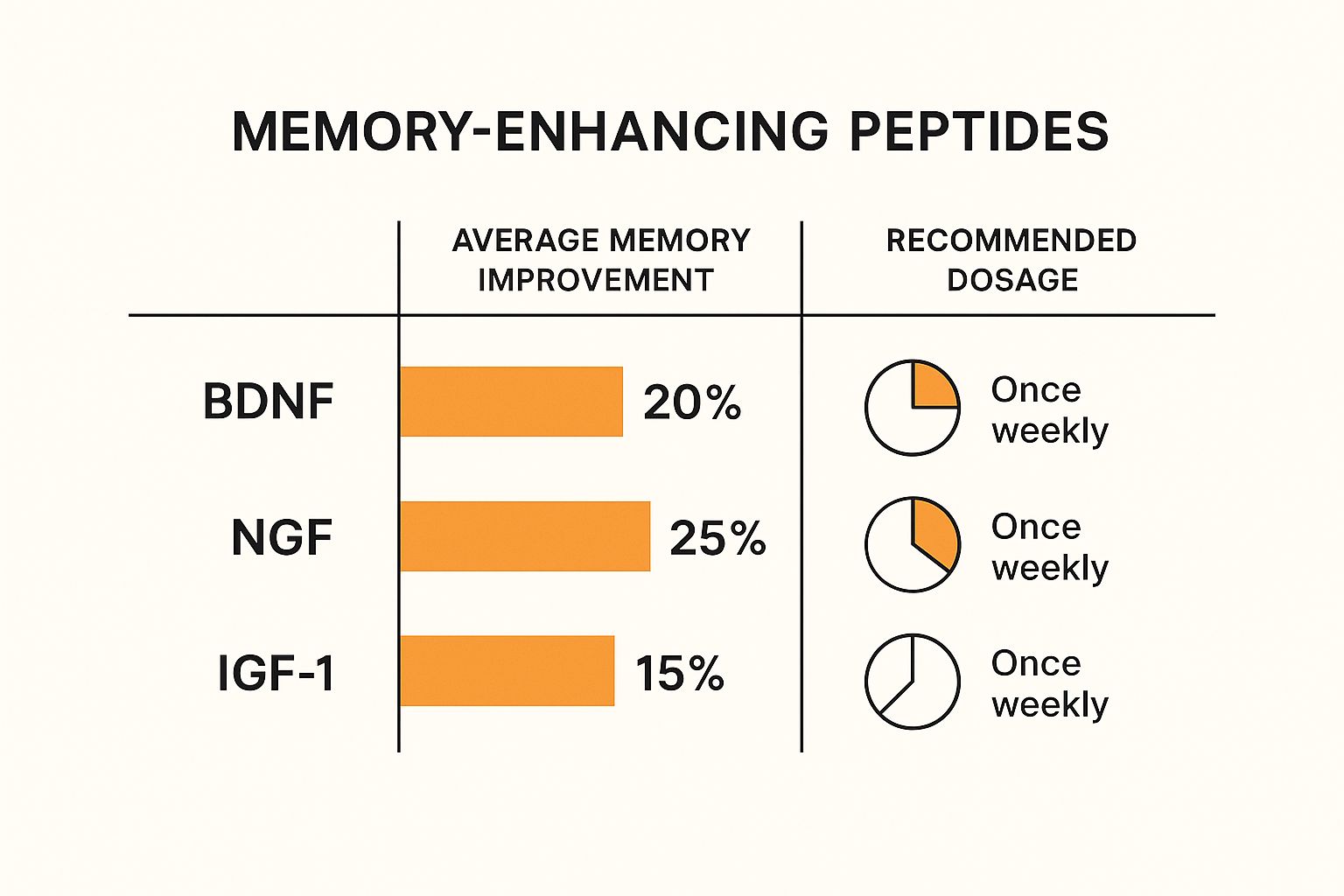
This chart clearly illustrates the different degrees of memory improvement and administration frequencies, reinforcing the idea that each peptide needs a tailored approach to get the best results.
To make these differences even clearer, let's compare these compounds side-by-side. The following table provides a snapshot of how each peptide works, what it's best for, and how it's typically administered.
Comparative Overview of Brain Health Peptides
A detailed comparison of popular peptides, their mechanisms, primary benefits, and administration methods.
| Peptide | Mechanism of Action | Primary Cognitive Benefit | Common Administration |
|---|---|---|---|
| Semax | Increases BDNF & NGF levels | Enhanced focus, mental clarity, and memory encoding | Nasal spray |
| Selank | Modulates immune molecules (interferons) to balance neurotransmitters | Anxiety reduction, mood stabilization, and stress resilience | Nasal spray |
| Dihexa | Potently activates the HGF/c-Met receptor pathway | Promotes long-term neurogenesis and synaptic formation | Subcutaneous injection or topical |
| Cerebrolysin | Multi-modal: neurotrophic, neuroprotective, and promotes plasticity | Comprehensive neuroprotection and cognitive recovery | Intramuscular or intravenous |
| BPC-157 | Modulates dopamine system, promotes angiogenesis | Systemic healing with secondary neuroprotective effects | Subcutaneous injection or oral |
This table serves as a quick reference, but as we'll see, the unique qualities of each peptide warrant a closer look, especially for the more powerful compounds.
Dihexa: For Advanced Neurogenesis
Dihexa really stands out because of its powerful and highly specific mechanism. It’s an incredibly potent binder to Hepatocyte Growth Factor (HGF), a protein that plays a central role in cell growth and repair. When Dihexa activates the HGF receptor, it's thought to set off a cascade that leads to the formation of entirely new connections between neurons.
Because of this unique potential to not just protect but actually build and repair neural pathways, Dihexa is being explored for its ability to address significant cognitive decline. Its effects aren't typically immediate but are aimed at creating long-term structural improvements to the brain's network.
Cerebrolysin: A Neuroprotective Blend
Unlike the single-molecule peptides we've discussed so far, Cerebrolysin is actually a mixture of neuropeptides and free amino acids, all derived from purified porcine brain proteins. It has a long history of clinical use in several European and Asian countries for serious conditions like stroke, traumatic brain injury, and dementia.
Cerebrolysin gets its work done through multiple mechanisms at once:
- Neurotrophic Activity: It mimics the action of natural growth factors like BDNF to support neuron survival and growth.
- Neuroprotection: It helps shield neurons from damage caused by oxidative stress and other harmful processes.
- Synaptic Plasticity: It supports the brain’s fundamental ability to form and strengthen connections.
This multi-pronged attack makes it a comprehensive tool for both neuroprotection and recovery.
BPC-157: The Systemic Healer with Brain Benefits
Known far and wide for its remarkable systemic healing properties—from repairing torn muscle tissue to healing the gut lining—BPC-157 (Body Protection Compound-157) also shows some surprising promise for brain health. Its neuroprotective effects are linked to its ability to modulate the dopamine system and protect the brain from various types of injury.
Research suggests BPC-157 can help lessen damage from chemical insults and may play a role in balancing neurotransmitter levels, which contributes to mood stabilization and overall cognitive resilience. While it's not a primary nootropic, its brain-supportive benefits are a significant and often overlooked part of its total healing profile.
Sorting Through the Science: What's Real and What's Experimental?
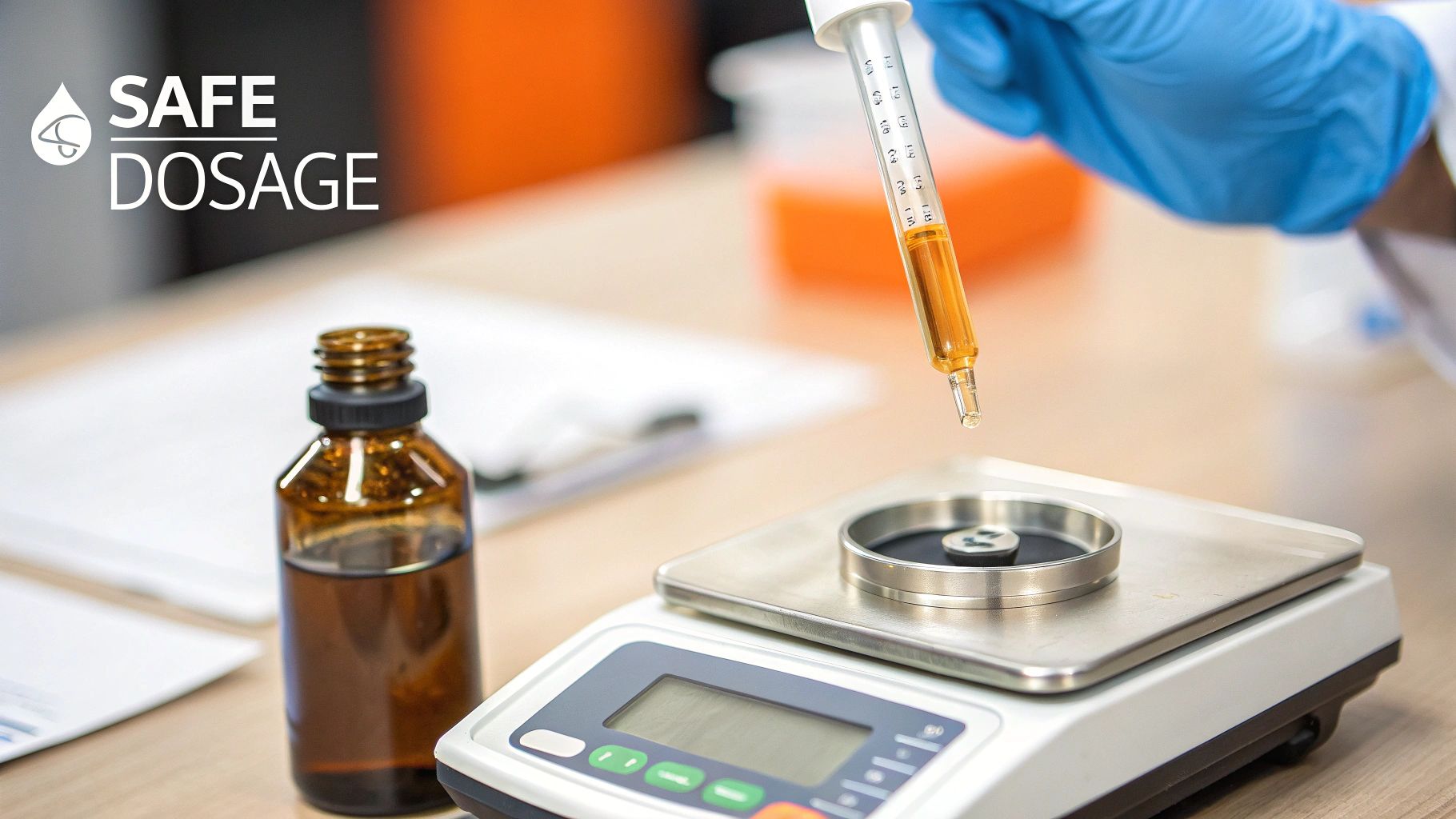
When you start looking into peptides for brain health, you'll find yourself navigating a landscape filled with incredible claims. The key is learning how to read between the lines with a critical eye. Not all evidence is the same, and it’s crucial to understand the difference between compounds with a long history of clinical use and those that are still in the early, experimental stages.
This distinction isn't just academic—it helps you set realistic expectations and understand where these molecules actually fit in the real world.
The interest in these compounds is booming, and it's far from a niche trend. The global peptide therapeutics market, which includes peptides for brain health and a host of other clinical uses, is on a serious upward trajectory. Valued at USD 45.15 billion in 2024, it's projected to climb to USD 83.75 billion by 2034. You can read more about the growth of the peptide therapeutics market to see just how much scientific and public interest is fueling this field.
This explosion in popularity makes it more important than ever to know how to sort through the hype and look at the actual science behind each peptide.
Established Use vs. Experimental Promise
The proof behind different brain-focused peptides exists on a wide spectrum. At one end, you have compounds that have been used in clinics for decades in some parts of the world. At the other, you have exciting new molecules that are still mostly confined to the lab.
A perfect way to see this contrast is by comparing Cerebrolysin and Dihexa.
Cerebrolysin: This peptide blend isn't new. It has been prescribed for decades in many European and Asian countries to treat serious neurological conditions like stroke and dementia. Because of this, it's supported by a huge body of human clinical data from those regions. Its safety and effectiveness, at least for those specific conditions, are well-documented within those medical systems.
Dihexa: This peptide is much newer and far more experimental. The buzz around it comes from its incredible power to stimulate neuron growth factor pathways in lab settings. It’s genuinely exciting stuff. But—and this is a big but—the vast majority of the research is preclinical, meaning it's been done in petri dishes or on animals. Solid human data is still very hard to come by.
This doesn't mean Dihexa has no potential; it just means it’s at a completely different point on the evidence timeline. Cerebrolysin is a tool that’s been field-tested in established medical practice for years, while Dihexa is more like a powerful, unverified prototype.
Think of it this way: It’s the difference between using a professional-grade tool that has been relied on for years and tinkering with a powerful new invention that's still on the test bench. Both have their place, but they demand very different levels of caution and understanding.
Reading the Research: A Skill You Need
When you see a claim about a peptide for brain health, learning to ask the right questions is your best defense. Not all "studies" are created equal, and a little knowledge goes a long way.
A single study showing a cool effect on lab-grown cells can tell us how a peptide might work, but it says almost nothing about how it will behave inside the complex, messy environment of a living human brain. This is where knowing the different types of studies becomes so important for making smart decisions.
A Quick Guide to Study Types
To help you size up the claims you find online, it helps to know what kind of research you're actually looking at. Here’s a simple breakdown, from the least to most definitive for human use:
In Vitro (Lab) Studies: These are experiments done in a petri dish on isolated cells. They're great for figuring out the basic mechanics of how a peptide works but tell us very little about its real-world effects, safety, or proper dosage in a living person.
Animal Studies: The next step up is research on animals, usually mice or rats. These studies show if a compound has the desired effect in a living system and give us early safety data. But as we all know, what works in a mouse doesn't always work in a human.
Human Clinical Trials: This is the gold standard. These are studies conducted on people, specifically designed to test a compound's safety and effectiveness with scientific rigor. The best ones are randomized, double-blind, and placebo-controlled to remove bias, giving us the most reliable data on whether a peptide actually works for a specific purpose in humans.
Navigating Safety, Sourcing, and Responsible Use
Jumping into the world of peptides for brain health takes more than just knowing what they do. You have to be seriously committed to safety, smart sourcing, and using them responsibly. These aren't your typical over-the-counter supplements; they're powerful compounds that demand respect and a clear-eyed view of the risks.
Let’s get the most important rule out of the way first: always consult a qualified healthcare professional before you even think about starting a peptide. A doctor can assess your specific health situation, explain the potential side effects, and keep an eye on your progress. Going it alone is a recipe for trouble, making professional oversight your most critical safety net.
The Critical Importance of Reputable Sourcing
The peptide market is a bit like the Wild West—largely unregulated. This creates a huge problem for consumers, as the quality, purity, and even the amount of active ingredient can vary wildly from one supplier to the next. Buying from a shady or unverified source is a massive gamble.
Peptides that are contaminated or poorly made can be loaded with harmful junk, be dosed all wrong, or contain none of the active ingredient you paid for. This can lead to a few frustrating outcomes:
- Ineffectiveness: The product does absolutely nothing, wasting both your time and money.
- Adverse Reactions: Who knows what’s really in that vial? Unknown substances could trigger allergic reactions or other nasty side effects.
- Serious Health Risks: Contaminants like heavy metals or endotoxins aren't just a minor issue; they can pose a real danger to your health.
To sidestep these pitfalls, only source peptides from suppliers who provide third-party lab testing results. This is your proof that the product is pure, correctly identified, and dosed accurately. Any reputable medical clinic prescribing peptides will insist on using products from trusted, vetted pharmacies.
A Certificate of Analysis (CoA) from an independent lab isn't just a piece of paper; it's your primary tool for confirming that a peptide is pure and accurately dosed. Without it, you are essentially flying blind.
Understanding Administration Methods
Peptides for brain health are usually given in ways that get around the digestive system, which would just chew them up and render them useless. The two most common methods are intranasal sprays and subcutaneous injections.
Intranasal Sprays:
This method is a favorite for brain-focused peptides like Semax and Selank. It offers a direct line to the brain through the olfactory pathways, helping it bypass the tough-to-cross blood-brain barrier. It’s also non-invasive and pretty simple to use.
Subcutaneous Injections:
This involves injecting the peptide into the fatty tissue just under your skin. It allows for super precise dosing and systemic absorption, which is perfect for peptides like BPC-157 or Dihexa. While it's more invasive, it's an incredibly effective delivery method when done right. For a full rundown on safety, our guide offers valuable insights into whether peptide therapy is safe when managed by a professional.
The Complex Legal Landscape
Finally, you need to be aware of the tricky legal status of peptides. The whole area is complex and can be downright confusing. Many peptides are sold with the "for research purposes only" label, which puts them in a legal gray area for personal use.
This label means they haven't been approved by agencies like the FDA for people to use. While some doctors can prescribe certain peptides through compounding pharmacies, buying them from "research chemical" websites online comes with both legal and safety risks. The only responsible way to navigate this space is to work within the medical system, ensuring you get a legitimate, high-quality product under professional supervision.
When we look at the horizon of brain medicine, it's clear that peptides are no longer on the fringes. They're quickly moving from specialized uses to becoming a central part of how we think about cognitive health and neurological treatment. What we're seeing now is just the tip of the iceberg. The real frontier is in developing next-generation peptides with surgical precision—molecules designed to bypass the brain's formidable defenses and deliver targeted results like never before.
The primary mission is to create peptides with superior brain permeability and specificity. Scientists are engineering new molecules that can slip across the blood-brain barrier more easily and then activate or inhibit very specific neural pathways. It’s like upgrading from a master key that opens many doors to a digital keycard programmed for a single, specific lock.
The Rise of Precision Neurotherapeutics
Incredible breakthroughs in biotechnology are making this possible. Researchers are now designing peptides that don't just manage symptoms but go after the root causes of neurodegenerative diseases. Picture a peptide specifically crafted to block the formation of amyloid plaques in Alzheimer’s or to shield the dopamine-producing neurons that are lost in Parkinson's.
This highly targeted strategy promises benefits that today's broader-acting drugs simply can't offer, very likely with fewer side effects. We are witnessing a fundamental shift toward proactive brain maintenance and repair, rather than just reactive treatment.
The ultimate goal is to move beyond mere symptom management. The focus is now on developing peptides that can actively intervene in disease processes, potentially halting or even reversing cognitive decline by addressing the specific cellular mechanisms that have gone wrong.
A Growing Global Movement
This scientific quest is happening alongside a massive global trend. Thanks to their wide range of biological activities, bioactive peptides have become one of the fastest-growing segments in both the pharmaceutical and wellness industries. The market is booming worldwide, with the USA projected to see a CAGR of 5.2%, Germany 7.6%, and India leading the pack with a remarkable growth rate of 9.4% through 2035. You can explore a detailed analysis of the bioactive peptide market’s global growth to see the full picture.
This economic energy is pouring back into research and development, creating a powerful cycle of discovery and application. As our understanding of the brain's complex signaling networks gets deeper, peptides will undoubtedly play a more central role in the future of cognitive longevity and neurological health. The potential of peptides for brain health is only just beginning to be unlocked.
Common Questions About Brain Health Peptides
Diving into the world of peptides for brain health naturally brings up a lot of questions. People want to know about safety, how quickly they can expect to see changes, and whether these compounds can be mixed with other nootropics. Getting clear, honest answers is the only way to make smart, responsible decisions about your cognitive health.
The legal and safety side of things can be a bit murky. Some peptides, like Cerebrolysin, are actually prescription medications in other countries, but many others fall into a gray zone, often sold with the tag "for research use only." This is exactly why you should never go it alone. Talking to a qualified medical professional is non-negotiable. A doctor can help you find your way through this landscape and make sure you get pure, high-quality products from legitimate compounding pharmacies, steering you clear of the very real risks of contaminated or fake substances sold online.
Setting Realistic Timelines and Expectations
One of the first questions everyone asks is, "How long until I see results?" The truth is, it's different for everyone. The answer depends on which peptide you're using, your own unique biology, the dose, and how consistently you stick with it. Some peptides, like Selank, might deliver noticeable anti-anxiety effects pretty quickly.
On the other hand, peptides that work on neurogenesis and long-term brain repair, such as Dihexa, are playing the long game. Their benefits aren't about getting an instant jolt of focus; they're about slowly rebuilding and improving brain structure over time. It’s crucial to go in with realistic expectations and see this as a long-term strategy, not a quick fix.
Combining Peptides with Other Nootropics
The idea of "stacking" peptides with other nootropics to get a synergistic effect is popular, but it demands extreme caution. When you start mixing multiple bioactive compounds, you can get unpredictable interactions—some good, some bad. Since every substance changes your brain chemistry in a different way, building a "stack" without professional guidance is a risky move.
A healthcare professional can help you understand potential interactions, preventing a well-intentioned effort from turning into a setback. Similarly, those exploring other health avenues should approach with care; for instance, our guide on peptides for weight loss emphasizes the importance of medical oversight. This principle applies universally when using powerful therapeutic agents.
Ready to explore how targeted therapies can support your cognitive and overall wellness goals? At Elite Bioscience, we provide doctor-guided access to high-quality, third-party tested peptide and hormone therapies. Take the first step towards optimized health by exploring our personalized treatment options at https://elitebioscience.co.
